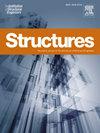海洋侵蚀环境下智能功能水泥基复合梁力学与自感知性能试验研究
IF 4.3
2区 工程技术
Q1 ENGINEERING, CIVIL
引用次数: 0
摘要
对海洋侵蚀环境下智能功能水泥基复合梁的力学性能和自感知性能进行了试验研究。测试参数包括电阻率测量方法、导电填充类型、补强率、环境类型(即自然环境、海蚀环境)。结果表明,在本研究的四种电阻测量方法中,第三种电阻测量方法是最合理的电阻测量方法,即通过该方法获得的测试数据可以更灵敏、全面、合理地反映测试梁的自感性能。导电填充材料类型、配筋率、海蚀环境(即电化学侵蚀)对试验梁的开裂荷载、极限荷载、开裂位移和极限位移均有显著影响。导电填充材料类型、配筋率、电化学侵蚀环境对试验梁的自传感性能均有显著影响。例如,配筋率越大,试验梁的自感知性能越差;电化学腐蚀时间越长,自传感性能越差。配筋率和电化学侵蚀环境对试验梁的荷载/电阻率-时间关系曲线变化有显著影响,而导电填充材料类型对荷载/电阻率-时间关系曲线变化影响较小。本研究可为海洋侵蚀环境下智能功能水泥基组合梁自感知性能的应用提供实验依据和深入认识。本文章由计算机程序翻译,如有差异,请以英文原文为准。
Experimental study on mechanical and self-sensing properties of intelligence-function cement-based composite beams under marine erosion environment
The mechanical and self-sensing properties of intelligent functional cement-based composite beams under marine erosion environment were studied experimentally. The test parameters involved are the resistivity measurement methods, types of conductive filling, reinforcement ratio, and environmental types (i.e., natural environment, marine erosion environment). The results showed that among the four resistance measurement methods in this study, the third resistance measurement method was the most reasonable resistance measurement method, that is, the test data obtained by this method can more sensitively, comprehensively and reasonably reflect the self-sensing performance of the test beams. The type of conductive filling material, reinforcement ratio, marine erosion environment (i.e., electrochemical erosion) significantly influenced the cracking load, ultimate load, cracking displacement, and ultimate displacement of test beams. The type of conductive filling material, reinforcement ratio, electrochemical erosion environment all had significant effects on self-sensing performance of test beams. For example, the greater the reinforcement ratio, the worse self-sensing performance of test beams; the longer the electrochemical erosion time, the worse the self-sensing performance. Reinforcement ratio and electrochemical erosion environment had a significant influence on curve variation of load/resistivity rate-time relationship of test beams, while the type of conductive filling material had a little influence on the curve variation of load/resistivity rate-time relationship. This study can provide experimental basis and in-depth understanding for the application of self-sensing properties of intelligent function cement-based composite beams under marine erosion environment.
求助全文
通过发布文献求助,成功后即可免费获取论文全文。
去求助
来源期刊

Structures
Engineering-Architecture
CiteScore
5.70
自引率
17.10%
发文量
1187
期刊介绍:
Structures aims to publish internationally-leading research across the full breadth of structural engineering. Papers for Structures are particularly welcome in which high-quality research will benefit from wide readership of academics and practitioners such that not only high citation rates but also tangible industrial-related pathways to impact are achieved.
 求助内容:
求助内容: 应助结果提醒方式:
应助结果提醒方式:


